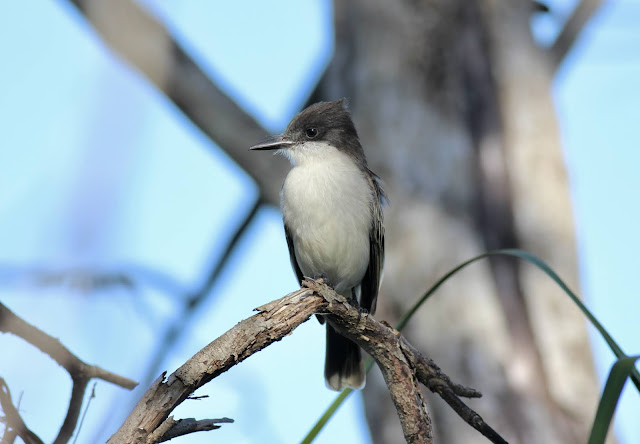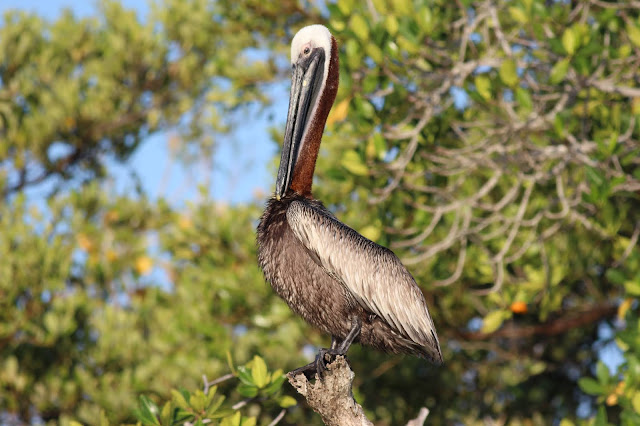We really only had one crack at this Cuban endemic that is restricted to a very limited range in the mountains. After a very nerve wracking period of hearing but not seeing it, we finally got some distant looks. A beautiful song!
Sunday, August 26, 2018
Olive-capped Warbler (Setophaga pityophila) - 30Dec2016
Although restricted to a very small range in Cuba, we saw this species on a couple different days in different areas. They can also be found in the Bahamas, but again not on Eleuthera which is where I go. Maybe if they can regrow some of the taller pines.
West Indian Woodpecker (Melanerpes superciliaris) - 29Dec2016
I guess I should have paid attention to the sub-species of this bird on Cuba as there are four and they could be split in the future. They can also be seen in the Bahamas but not on Eleuthera where I usually go. This one was photographed the first day in the Sierra del Rosario. A pretty cool looking bird which I will have to crush properly later.
Loggerhead Kingbird (Tyrannus caudifasciatus) - 29Dec2016
I have seen this species in the Bahamas before but this was the first one I have a decent photo of. This one was taken on my first day in Cuba in the Sierra del Rosario. The Loggerhead has a much more differentiated cap than the Gray Kingbird and actually looks more like a very beefy Eastern Kingbird.
Here is one from a couple days later in Cuba.
Cuban Trogon (Priotelus temnurus) - 29-30Dec2016
A beautiful bird in person that does not come across as impressively on a photo, at least the ones I obtained. This is the only trogon found on Cuba.
Greater Antillean Grackle (Quiscalus niger) - 29Dec2016
Here is another very common bird all over Cuba and this was photographed immediately upon disembarking from our tour bus at the Reserva de la Biosfera Sierra del Rosario.
Sunday, August 19, 2018
Cuban Blackbird (Ptiloxena atroviolacea) - 29Dec2016
Known as Totí, the Cuban Blackbird is found all over the main island of Cuba. In fact it was the first bird I photographed as we came out of our tour bus and stretched our legs. The similar Greater Antillean Grackle has a pale iris and longer bill.
Hooded Merganser (Lophodytes cucullatus) - 26Dec2016
Probably the coolest looking bird in Wilmington, the Hooded Merganser is fairly common in the waterways all over the Port City. This one was photographed at Fort Fisher. When they are getting ready to mate, they will do all kind of crazy head bobbing to impress the ladies.
Baltimore Oriole (Icterus pectoralis) - 22Dec2016 & 01Jan2019
Although Baltimore Orioles primarily come through NC during migration, we have some that winter with us eating copious amounts of grape jelly. This one was photographed in my yard.
Here is one from my friend Nancy's house in 2019.
Here is one from my friend Nancy's house in 2019.
Here is a nice male at my house in Wilmington just after a rare snow in 2018.
Snow Bunting (Plectrophenax nivalis) - 14Dec2016 and 21Jan2017
Love Snow Buntings! Here are some photos from Ipswich Massachusetts.
And some photos closer to home on the OBX of NC.
And some photos closer to home on the OBX of NC.
Brown Pelican (Pelacanus occidentalis) - 11Dec2016 & 18Apr2019
An ever present bird in Wilmington, NC near the coast. That being said, they will never get old and I love watching them float by and hover just above the waves. Back when I used to surf more, I would wait for waves and be totally content watching the pelicans fly by sometimes within several feet of my head. This one was cruising by the end of the Johnny Mercer Pier in Wilmington, NC.
Here is a breeding plumaged bird from Rio Lagartos in the Yucatan.
Ruddy Turnstone (Arenaria interpres) - 11Dec2016
The Ruddy Turnstone in breeding plumage is a little garish and over the top. Perhaps if it was a rarity, it would not be taken for granted. I can appreciate them more in the winter when they are not so clownish, like this one taken on the pier at Wrightsville Beach, NC.
Willet (Tringa Semipalmata) - 11Dec2016
I like this image taken on the pier at Wrightsville Beach, NC because this Willet is chilling out (literally). Willets in breeding seasons are a big pain in my butt. Try and be a quiet bird-ninja in the marsh or on the beach and Willets will always give you away. They call non-stop and will circle you letting all the other birds you are lurking near by. It gets very annoying after about 10 minutes.
Slaty-backed Nightingale-Thrush (Catharus fuscater) - 29Nov2016
For some reason I have had terrible luck with Nightingale Thrushes, but this day the gods favored me. The Slaty-backed can be told from others by the light colored iris. Photo taken at La Paz Waterfall Gardens.
Olivaceous Woodcreeper (Sittasomus griseicapillus) - 29Nov2016
One of the easiest woodcreepers to identify due to the contrasting head and body! This one was on my last day of vacation at La Paz Waterfall Gardens.
Gray-breasted Wood-Wren (Henicorhina leucophrys) - 29Nov2016
This is the highlands version of the White-breasted Wood-Wren. You can just make out the gray breast in the shadow. Photographed at La Paz Waterfall Gardens.
Torrent Tyrannulet (Serpophaga cinera) - 28Nov2016
Much like the American Dipper, this little bird makes it's home near or on fast moving streams. This one was photographed at La Paz Waterfall Gardens in Costa Rica.
Green Thorntail (Discosura conversii) - 28Nov2016
This little elusive hummer is fairly uncommon but La Paz Waterfall Gardens is a good spot for them.
Here is the male with the long tail.
This is the female.
Here is the male with the long tail.
This is the female.
Brown Violetear (Colibri delphinae) - 28Nov2016
The Brown Violetear is much less common than the Lesser Violetear but I have seen a few at the La Paz Waterfall Gardens in Costa Rica where this one was photographed.
Subscribe to:
Posts (Atom)

















































